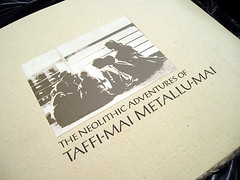
The Neolithic Adventures of Taffi-mai Metallu-mai: How the First Letter Was Written and How the Alphabet Was Made, Just So Stories by Rudyard Kipling.
The primal tales of the Just So Stories, created in response to the innocent queries of Kipling's oldest daughter, existed in oral form long before publication. Kipling refined them through continual retellings and introduced drawings also meant to answer questions in an elemental manner. The two tales that comprise this edition, “How the First Letter Was Written,” and “How the Alphabet was Made,” were chosen because of their shared heroine (the author's Neolithic inventor of writing), and their affinity with subjects related to the lettering arts. Kipling’s petroglyph-like drawings reinforce the primal nature of the tales.
Perhaps the most elaborate of all the Kipling fine and private press editions.—Parenthesis
Produced by Gerald Lange, the work has some intriguing features:
The text sheets were individually water colored in the ancient urazaiskiki manner and printed damp. Kipling’s drawings (cumbersomely executed in previous editions) were printed on separate sheets and inserted between the folded leaves of the edge-sewn binding, revealing themselves in the background of the story.
Letterpress printed from handset Monotype Pastonchi and a digitally altered version of Berthold Post Antiqua, the book was hand bound with hinged covers, tortoise shell pattern stitching and hardwood spine. A number of exotic Asian handmade papers were used in the production: Kitakata for text, Gampi for inserts, Kasuiri and Chirizome for end sheets, Cogan Grass for covers. A multi-colored photo-print of Kipling entrancing a group of children with his storytelling, provides entry into the book.
The careful attention to detail and integration of elements enhance the presentation of the stories and make this an exceptional edition. A grassy scent rising from the pages adds to the magic.—Califia Books
10-1/4 by 8-1/2 inches. 55 pages with 17 additional illustrated page inserts. Edition limited to 150 numbered copies. [Only 79 copies were completed in binding state—which is out-of-stock]. Marina del Rey, 1997. Unbound sheets, $675.